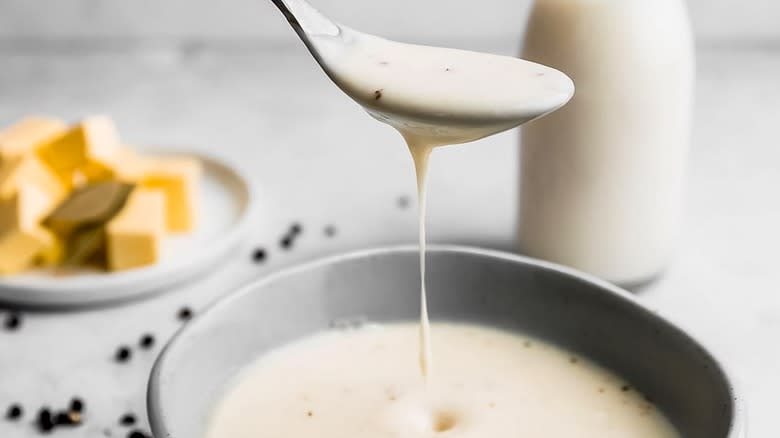How To Store Leftover Béchamel The Right Way

It's hard to imagine having leftover béchamel, the delightfully creamy white sauce that goes with, well, anything. That's especially true for French and Italian cuisine, with both countries vying for origin claims. Regardless of who invented béchamel, popularized it, or made the technique accessible to everyone, it's a sauce that's generously portioned and now consumed in countless dishes around the world. If you do end up with leftover béchamel, all the better, since it's completely storable for future use.
The right way to store béchamel begins with determining how soon you'll use the leftover sauce. For many, that would be pretty quickly, considering that it works equally well in breakfast dishes, ladled over eggs or potatoes, and in quick-lunch mac & cheese or baked into lasagna, casseroles, or meat pies. In other words, there's little need to worry about it going bad, as long as you place it in a covered airtight container and store in the refrigerator for up to three days.
Reheating béchamel is easy, though you do need a hands-on approach. Skip the microwave if possible, to avoid uneven heating and clumping. Instead, bring the sauce to a gentle simmer on the stovetop, stirring often. To reconstitute the original creamy texture, use a whisk. Add cold milk if necessary to make it pourable, depending on how you'll be using it in this second iteration. There's another storage option if you've seriously overestimated the volume, or purposefully made extra for later use.
Read more: 30 Healthy Snack Ideas That Won't Ruin Your Diet
Béchamel Stands Up To Freezing Temps

You know how some things just don't hold up well when frozen? Béchamel isn't one of those things. In fact, it does just fine in the freezer, at least for up to three months. As with any freezer-compatible food, the key to survival is proper preparation before entering its frozen slumber. If the sauce is still warm, bring it to room temperature before transferring to freezer-safe containers. Typical options include closed containers, plastic freezer bags, vacuum sealed pouches, or for smaller amounts, ice trays.
Going the ice-tray route, though convenient for future single portions, has a major disadvantage of lacking convenient covers, which is crucial for retaining freshness and quality. A relatively new option, particularly if you're trying to avoid plastic in your kitchen, is the Souper Cube freezer trays of Shark Tank fame. They're made of food-grade silicone, with no BPA, PVC, lead, phthalates, or other concerning elements, and they're flexible enough to pop out a single portion from the segmented container slots. The newer versions come in portions as small as one ounce, half cup, and all the way up to two cups.
Regardless of your freezing method, be sure to thaw the béchamel in the refrigerator overnight or for several hours. For quicker defrosting, you can keep it covered and run cool water over the top. Again, microwaving would be your last resort. After all, a cherished sauce like béchamel deserves some extra loving care.
Read the original article on Tasting Table.


